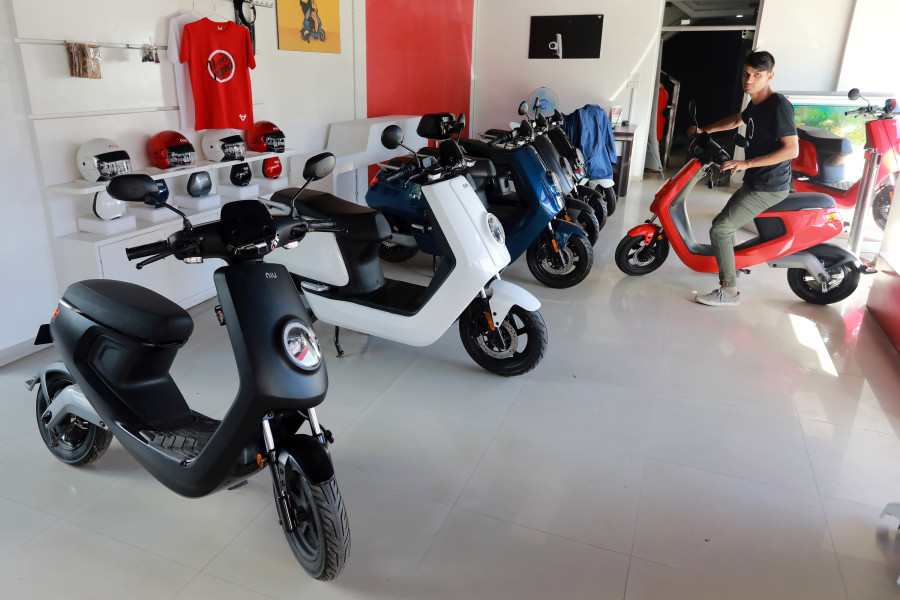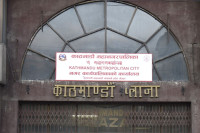Valley
Roadworthiness test for e-scooters irks riders, promoters and sellers
As per a new government rule, the test—among many other requirements—includes riders to complete an uphill ride to Seto Gumba with a pillion rider
Chandan Kumar Mandal
Four years ago, Umesh Shrestha bought three electricity-powered scooters, for personal and official purposes, in the immediate aftermath of the 2015 border blockade that caused a massive shortage of fuel in the country.
Since using the e-scooters instead of petrol-run motorbikes, he has been saving at least Rs4,000 on fuel expenses every month, according to Shrestha.
“With one-time charge, which hardly consumes one unit of electricity, an e-scooter runs for nearly 70km every day, saving at least Rs200,” said Shrestha, who is also the chairperson of the Electric Vehicles Association of Nepal.
“We all were very satisfied with these electric vehicles. We were planning to buy a few more,” added Shrestha, who says his company is now unsure whether the huge investment should be made after the government last week decided that e-scooters must be registered with the Department of Transport Management. None of Shrestha’s e-scooters are registered.
Along with this, what worries hundreds of e-scooters riders like Shrestha more is the ‘roadworthiness’ test these e-vehicles must pass as per the new government rule.
Among a host of other things, the test includes completing an uphill ride along the steep road of Seto Gumba, a Buddhist monastery located in the western part of Kathmandu valley. The e-scooter needs to complete the uphill ride with a rider and a pillion rider to complete the test.
“I heard that a scooter of the Benlin Company was taken to the Seto Gumba, and it failed the test. I don’t know why the test needs to be conducted on a location where even a few petrol-run motorbikes cannot go,” Shrestha said.
The Vehicle Fitness Test Centre of the Department of Transport Management (DoTM) conducts the ‘roadworthiness’ test for electric vehicles by examining their battery capacity, motor power, energy storing capacity of the battery, mileage after full charge, braking distance and its capability to go uphill on varied levels of elevation, among others.
The location for assessing e-vehicles’ capacity to go uphill is disputed between e-vehicle promoters and government bodies. According to e-vehicle promoters, the international standard for checking roadworthiness of an e-scooter is an elevation of maximum eight degrees.
“The vehicle fitness test centre doesn’t have the required equipment and standards for vehicle testing so they have haphazardly selected Seto Gumba,” said Shrestha.
When the transport department was approached by the Post, Kumar Prasad Dahal, the director general, said that the department will not register any e-vehicles which fails to travel the eight-degree elevation.
So how does the Seto Gumba climb decide a vehicle’s roadworthiness?
“What’s the problem with that? Our technicians chose a place when it meets the eight-degree criteria. They might have thought the location as scientific and considered it for the roadworthiness test for e-vehicles,” Dahal told the Post. “We believe that if these e-scooters can go uphill to the Seto Gumba point then it can go anywhere in the valley. Failing to do so means no registration inside the valley.”
E-vehicle promoters and environmentalists find such provision of uphill ride exclusively for e-scooters as ‘discriminatory’ and contradictory to the government’s own plans and policies of promoting e-vehicles in the country.
“If the country wants to genuinely promote e-vehicles, it should reflect that in its favourable policies,” said Bhushan Tuladhar, an environmentalist and chairperson of Clean Energy Nepal. “Testing the roadworthiness of e-scooters, bikes and other e-vehicles like buses at the current location of Seto Gumba is not justified. If we do not have the standard, we could have adopted it from countries like India and China.”
In recent years, the government has made firm commitments to increasing the number of e-vehicles in the country’s total vehicle share in a bid to reduce air-pollution as well as reduce the dependency on fossil fuels. To this effect, there have been many initiatives taken by the government and non-government sectors towards creating an enabling environment for the promotion of e-vehicles in the country.
The Environment-friendly Vehicle and Transport Policy (2014) was adopted with an aim to cut off emission from the transport sector and increase the share of e-vehicles to up to 20 percent by 2020. However, the growth has not been encouraging so far.
According to Shrestha, any vehicle like an e-scooter going at the speed of maximum 30-35km per hour is simply considered a bicycle and does not require any registration and license for riding.
“The e-scooters have been taken up by mostly old population, women and those who cannot afford petroleum-run expensive vehicles. They ride it along the cycle lane. India and China promote that way,” said Shrestha. “Now this sudden decision of asking them to register and go through the roadworthiness test looks like a move to force them to go back to fossil-fuel vehicles.”
The department estimates that there are 2,500-3,000 e-scooters that have not been registered so far. A 15-day deadline has been given to these vehicles to complete the registration, but registration is possible only if they pass the roadworthiness test.
“In the last few years, many Chinese companies have come here and sold their products haphazardly without maintaining any specification,” said Dahal. “We are wondering if these unregistered e-scooters can even complete the required eight-degree elevation test. Without registration, there were issues of vehicle number plates and riders safety.”
Tuladhar, however, disagrees with such test being mandatory for all kinds of e-vehicles—as not every vehicle is designed to go uphill.
“Small e-scooters should not be made to go through such an uphill test. If I buy an e-scooter which doesn’t climb a steep road like Seto Gumba, I would be concerned with that,” said Tuladhar. This test is unfair for e-vehicles as the department accepts fossil-fuel vehicle manufacturers’ specifications as a reliable document for roadworthiness.
For petroleum-run vehicles, the government conducts a roadworthiness test of a sample vehicle and technical details mentioned in the specification are acceptable, said Dahal.
“Now we will be enforcing the eight-degree elevation uphill on the importers so any vehicle not meeting that criteria cannot enter without completing the roadworthiness test. Earlier, it was sold and bought like any other electronic item,” added Dahal. “The users need not worry later on as the test will be conducted before such e-scooters are imported. For those who have not registered yet, they have to go through the test.”
The government decision of asking e-scooter owners to register has also left its effects on the sale of these vehicles.
Gehendra Bajracharya, a proprietor of BG Video and Electronics, which sells nearly 10 brands of electric two-wheelers, has not sold a single vehicle since the department announced the decision.
“This decision has affected the overall sales of e-scooters especially at a time when people had started switching to electric two-wheelers. I used to sell at least five-six vehicles every month,” said Bajracharya.
According to him, this provision should have been enforced on importers at the time these vehicles entered the country rather than causing unwanted trouble to riders.
“The traffic has started imposing fines. All of us need time to complete the procedure,” added Bajracharya.
“The eight-degree elevation can be completed by any e-scooter but if the electric two-wheeler will go to Seto Gumba for the test, the battery will already be drained out. They should rather build a long ramp with a similar elevation to conduct the test.”




 12.12°C Kathmandu
12.12°C Kathmandu











